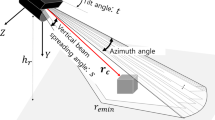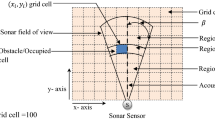Abstract
We propose a sequential method to extract 3-dimensional information for mapping by using sensor fusion of two sonar devices. The 3D reconstruction using sonar images from forward-looking multibeam sonar (FLMS) is an ill-posed problem due to the loss of elevation angle; thus we used an additional sonar and its complementary information. Our approach is to utilize geometric constraints between the installation of two sonar devices and complementary characteristics such as a different angle of the acoustic beams and data acquisition method. The fusion process proceeds in three stages. The first stage is to build a likelihood map using geometric constraints of the installation between two sonar devices. The second stage is to calculate the feasible elevation angle of the FLMS. The elevation angle of FLMS is limited by its vertical beam spreading angle, which can be represented by particles. The third stage is Monte-Carlo experiment using the generated particles by computing the weight, and correct the data of FLMS. To verify the proposed method, we applied the proposed method in simulations and experiments in engineering basin with an AUV.
Similar content being viewed by others
References
M. D. Aykin and S. Negahdaripour, “Three-dimensional target reconstruction from multiple 2-D forward-scan sonar views by space carving,” IEEE Journal of Oceanic Engineering, vol. 42, no. 3, pp. 574–589, 2017.
T. Guerneve, K. Subr, and Y. Petillot, “Three-dimensional reconstruction of underwater objects using wide-aperture imaging SONAR,” Journal of Field Robotics, vol. 35, no. 6, pp. 890–905, 2018.
E. Galceran, R. Campos, N. Palomeras, D. Ribas, M. Carreras, and P. Ridao, “Coverage path planning with real-time replanning and surface reconstruction for inspection of three-dimensional underwater structures using autonomous underwater vehicles,” Journal of Field Robotics, vol. 32, no. 7, pp. 952–983, 2015.
E. Coiras and J. Groen, “3d target shape from as images based on a deformable mesh,” Proceedings of the 3rd International Conference on Underwater Acoustic Measurements (UAM), 2009.
M. Moszynski, K. Bikonis, and Z. W. Lubniewski, “Reconstruction of 3D shape from side scan sonar images using shape from shading technique,” Hydroacoustics, vol. 16, pp. 181–188, 2013..
T. A. Huang and M. Kaess, “Towards acoustic structure from motion for imaging sonar,” Proc. of IEEE/RSJ International Conference on Intelligent Robots and Systems (IROS), pp. 758–765, 2015.
S. Negahdaripour, “Application of forward-scan sonar stereo for 3-D scene reconstruction,” IEEE Journal of Oceanic Engineering, 2018. DOI: https://doi.org/10.1109/JOE.2018.2875574
M. D. Aykin and S. Negahdaripour, “On feature matching and image registration for two-dimensional forward-scan sonar imaging,” Journal of Field Robotics, vol. 30, no. 4, pp. 602–623, 2013.
H. Cho and S.-C. Yu, “Real-time sonar image enhancement for AUV-based acoustic vision,” Ocean Engineering, vol. 104, pp. 568–579, 2015..
H. Cho, J. Gu, H. Joe, A. Asada, and S.-C. Yu, “Acoustic beam profile-based rapid underwater object detection for an imaging sonar,” Journal of Marine Science and Technology, vol. 20, no. 1, pp. 180–197, 2015.
J. Kim, M. Sung, and S.-C. Yu, “Development of simulator for autonomous underwater vehicles utilizing underwater acoustic and optical sensing emulatorsm” Proc. of 18th International Conference on Control, Automation and Systems (ICCAS), pp. 416–419, 2018.
C. Perreault and M. F. Auclair-Fortier, “Speckle simulation based on B-mode echographic image acquisition model,” Proc. of 4th Canadian Conference on Computer and Robot Vision (CRV’07), pp. 379–386, 2007.
E. Belcher, W. Hanot, and J. Burch, “Dual-frequency identification sonar (DIDSON),” Proceedings of the International Symposium on Underwater Technology (Cat. No. 02EX556), pp. 187–192, 2002.
H. Cho, B. Kim, and S.-C. Yu, “AUV-based underwater 3D point cloud generation using acoustic lens-based multibeam sonar,” IEEE Journal of Oceanic Engineering, vol. 43, no. 4, pp. 856–872, 2017.
H. Joe, M. Kim, and S.-C. Yu, “Second-order sliding-mode controller for autonomous underwater vehicle in the presence of unknown disturbances,” Nonlinear Dynamics, vol. 78, no. 1, pp. 183–196, 2014.
J. Pyo, H. Cho, H. Joe, T. Ura, and S.-C. Yu, “Development of hovering type AUV “Cyclops” and its performance evaluation using image mosaicing,” Ocean Engineering, vol. 109, pp. 517–530, 2015..
Author information
Authors and Affiliations
Corresponding author
Additional information
Publisher’s Note Springer Nature remains neutral with regard to jurisdictional claims in published maps and institutional affiliations.
Recommended by Associate Editor Jinwhan Kim under the direction of Editor-in-Chief Keum-Shik Hong. This research was supported by the MSIT(Ministry of Science and ICT), Korea, under the ICT Consilience Creative program (IITP-2018-2011-1-00783) supervised by the IITP(Institute for Information & communications Technology Promotion), and was a part of the project titled ‘Gyeongbuk Sea Grant’, funded by the Ministry of Oceans and Fisheries, Korea.
Hangil Joe received his B.E. degree in mechanical engineering in 2012 from Pusan National University, Busan, Korea, and an M.S. degree in ocean engineering in 2014 from Pohang University of Science and Technology (POSTECH), Pohang, Korea. He earned a Ph.D. degree from the Department of Creative IT Engineering at POSTECH in 2019. Currently, he is a post-doctoral researcher in the Department of IT Engineering at POSTECH. His research interests include underwater robotics, underwater perception, and SLAM.
Jason Kim received his B.S. degree in computer engineering in 2018 from Ulsan National Institute of Science and Technology (UNIST), Ulsan, Korea. Currently, he is an M.S. candidate in the department of creative IT engineering at Pohang University of Science and Technology (POSTECH), Pohang, Korea. His research interests include computer simulation, underwater optical/sonar image processing, and SLAM.
Son-Cheol Yu received his B.E. degree in naval architecture and ocean engineering from Inha University, Incheon, South Korea, in 1998 and his M.E. and Ph.D. degrees in ocean and environmental engineering from The University of Tokyo, Tokyo, Japan, in 2000 and 2003, respectively. From 2008 to 2010, he was a faculty member with the School of Mechanical Engineering, Pusan National University, Busan, Korea. Since 2010, he has been a faculty member at Pohang University of Science and Technology (POSTECH), Pohang, Korea. His research interests include autonomous underwater vehicle systems and hazardous environmental robotics.
Rights and permissions
About this article
Cite this article
Joe, H., Kim, J. & Yu, SC. 3D Reconstruction Using Two Sonar Devices in a Monte-Carlo Approach for AUV Application. Int. J. Control Autom. Syst. 18, 587–596 (2020). https://doi.org/10.1007/s12555-019-0692-2
Received:
Revised:
Accepted:
Published:
Issue Date:
DOI: https://doi.org/10.1007/s12555-019-0692-2




